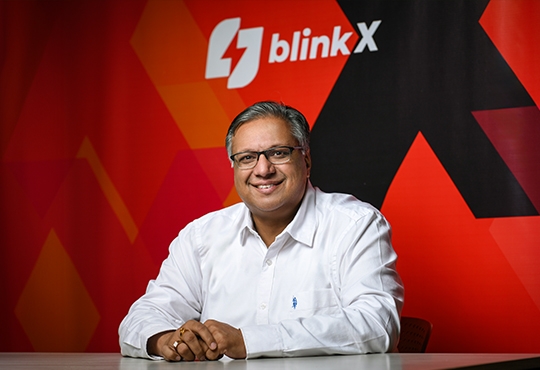
Making Informed Financing Decision and Reducing Credit Risk
Abhishek Sharma, Chief Digital Officer, L&T Financial Services | Sunday, 16 October 2022, 18:05 IST
 Abhishek Sharma, Chief Digital Officer, L&T Financial Services, in interaction with CIOTech- Outlook, shares his insights on the financial services industry, wherein he talks about the critical aspects relating to data silos, paper-intensive processes, and more.
Abhishek Sharma, Chief Digital Officer, L&T Financial Services, in interaction with CIOTech- Outlook, shares his insights on the financial services industry, wherein he talks about the critical aspects relating to data silos, paper-intensive processes, and more.
Exponential growth in information tech- nology has prompted companies to leverage digitization to transform the financial services industry. In this regard, how do you see the role of digital officers developing today?
In a technology-enabled business model, the role of a digital officer has been of rising importance. Starting from the user journey, digital officers massively influence the way a user gets embedded within the organization. He also plays a crucial part in developing credit algorithms and defines the way credit underwriting risk is undertaken through data availability. Servicing is yet another domain that requires due attention of the digital officer to appropriately fulfill the customer servicing needs. Lastly, a digital officer also plays his part in understanding customer behavior and how they interact with the organization from a lending viewpoint. Operating in the four different avenues, this role tends to act like a glue between analytics, technology, and an organization’s digital journey.
Data in the financial industry can be highly siloed, causing inefficiencies across the lending life cycle. How can an integration be achieved to boost the flow of information and collaboration?
In the financial service sector, data plays a crucial role in understanding customer behavior to determine credit risk. As all the major actions of an organization are heavily influenced by data, the big players of the industry have been proactive in eliminating the existing silos to harness data to its optimum level.
However, when viewed from a broader perspective, there are certain limiting factors that are disturbing the growth of the financial service industry as a whole. For instance, the recent initiative by the RBI in regard to Account Aggregator Network is not taking a positive momentum. The financial sector comprises multiple players and once data generated from different sources are centralized, it will help the industry make better-informed decisions. If the initiative is properly undertaken, the cost of onboarding for all financial services players is likely to come down, which in turn will be beneficial for the customers, as it will lead to a lower interest rate. More specifically for the rural sector, this will bring new possibilities as the cost of acquisition is higher than in the urban segment.
Manual, paper-intensive processes are not enough to address the evolving needs of small businesses. Today, there is an increasing need to optimize the loan approval process and reduce disbursement time. How can this be attained?
The pandemic has been a key facilitator in fast-tracking the journey toward a paperless lending model. Multiple government initiatives like eKYC verification and e-sign based on Aadhaar have enabled the growth towards digitization. Fintechs have also played their part in bringing together financial statements in a digital format.
Although most of the financial service players and processes have moved beyond paper-based actions, few operations like – home loans are still dependent on paper-based procedures. Government and the organizations need to maintain a proactive stance to eliminate all the inefficiencies in the ecosystem.
A comprehensive paperless ecosystem will help in bringing down the cost of operations while enabling overall credit growth and bringing down the interest rate.
Farmers often do not have adequate and timely access to financial services and have poor financial literacy. Without transactional records, financial institutions have to rely on self-reported information of farmers, which may not be enough or accurate for credit scoring. How is the industry working to mitigate this issue?
Although financial operations in the rural segment were a complicated process, it has been mitigated to a large extent. For instance, large players like LTFS, who have been in this industry for way too long, have seen various cycles through which the agriculture industry has gone through and the behavior of underlying customers over a period of time.
This has helped us develop our own proprietary algorithms to determine the credit risk involved. Moreover, the expanding use of technology in the industrial service sector is bringing new opportunities to digitize the rural lending process as well. In the tractor financing domain of LTFS, we have digitized the entire process through the combination of proprietary algorithms, technology interventions like – geotagging, AI, and more to take an informed decision. Thanks to the Aadhaar-based subsidy model, the agriculture sector also is not data-blind anymore.
How do you see the financial service sector evolving in terms of new technology adoption?
Viewing from a financial services perspective, technological interventions will be aimed at the factors that help bring down the cost of operations. For instance, factors such as the cost of onboarding, faster service alternatives, etc., will be decisive in the coming days. These will help the organizations bring down the overall cost, making them organization more competitive. Secondly, the continued flow of data will help financiers make more informed decisions, thereby reducing the credit risk.
With increasing credit growth in the post covid era and decreasing credit risks, the financial industry is on the path of betterment as the year progresses.
CIO Viewpoint
Making Informed Financing Decision and Reducing...
By Abhishek Sharma, Chief Digital Officer, L&T Financial Services
Financial Services Sector Progresses Towards...
By Ravi Kethana, Chief Platform Officer, CAMS
Making Financial Services Industry Digital-first
By Dhaval Pandya, Corporate CIO, Piramal Enterprises Limited
CXO Insights
Unveiling FinTech Trends for 2024: Letting the...
By Sameer Danave, Senior Director Marketing, MSys Technologies
The Role of Big Data in Market Forecasting
By GaganSingla, MD, Blinkx
Budget 2023: Measures that will help the IT...




.jpg)
.jpg)




